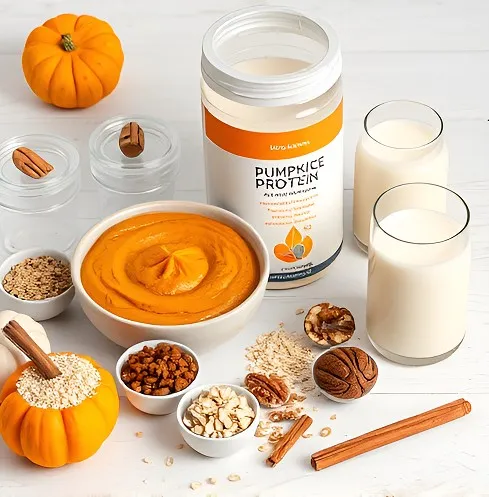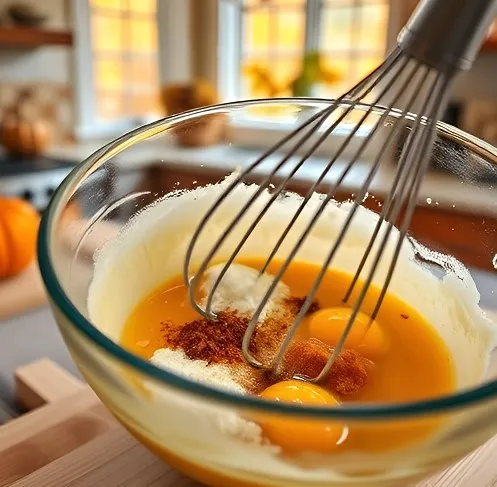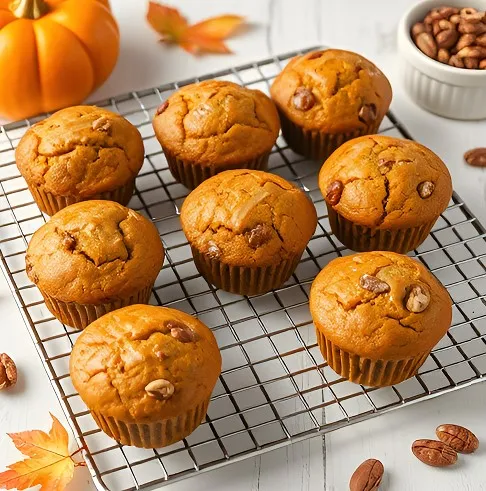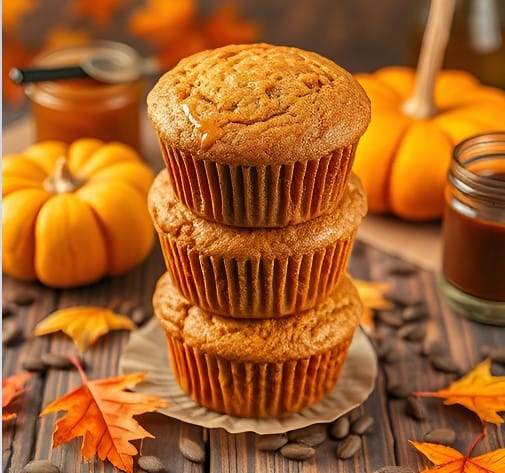Autumn is here, and with the cooler weather comes the urge to indulge in warm, comforting treats that don’t derail your healthy lifestyle. Today, I’m excited to share with you one of my absolute favorite recipes: protein pumpkin muffins. These muffins are not only bursting with seasonal flavor, but they also pack a nutritional punch that makes them a perfect snack or even a light meal on the go.
Table of Contents
Why Choose Protein Pumpkin Muffins?
Autumn recipes have a magical way of combining comfort with health, and protein pumpkin muffins embody this fusion perfectly. The traditional pumpkin muffin is a seasonal treat, reminiscent of harvest time and crisp evenings spent sipping on warm beverages. By adding protein into the mix, these muffins transform into a balanced option that supports an active lifestyle.
Pumpkin provides an excellent source of vitamin A, fiber, and antioxidants, while the protein (from whey, pumpkin seed protein, or other high-quality powders) helps with muscle recovery and sustains your energy levels. The result is a muffin that’s damp, flavorful, and supremely satisfying whether you’re grabbing one post-workout or pairing it with your morning coffee. This recipe is a fantastic way to enjoy a sweet treat without compromising your health goals.
The Key Ingredients: What Goes Into Protein Pumpkin Muffins
When it comes to creating the perfect protein pumpkin muffin, the ingredients list is crucial. Each component plays an important role, from balancing the flavors to achieving the right texture. Here’s a rundown of what you need:
- Pumpkin Puree: The star of the show. Pumpkin puree lends a creamy texture and a subtly sweet flavor while adding essential nutrients.
- Protein Powder: This can be any high-quality protein powder of your choice. Whey protein is popular, but plant-based options work just as well. For an extra twist, consider using pumpkin seed protein, which not only increases the protein content but also adds a delightful nutty flavor.
- Whole Wheat Flour and Oats: Whole grains provide fiber and a heartier texture. Mixing them with almond flour or another nut flour can offer additional nutrients and reduce gluten content.
- Eggs or Egg Substitutes: They act as the binding agent and add moisture to the muffins.
- Baking Powder and Baking Soda: These leavening agents help the muffins rise beautifully.
- Liquid Base: Almond milk, oat milk, or any dairy/non-dairy milk ensures the right batter consistency.
- Spices: Cinnamon, nutmeg, and ginger amplify the autumnal vibe, while a touch of vanilla extract rounds out the flavor profile.
- Natural Sweeteners: Maple syrup, honey, or dates sweeten the muffins without resorting to refined sugar.
- Healthy Fats: A bit of coconut oil or Greek yogurt not only enriches the flavor but also keeps the texture soft and moist.
Each ingredient has been chosen to complement the others, making sure that every bite bursts with flavor while providing the nutrients your body needs.

The Health Benefits of Protein Pumpkin Muffins
Protein pumpkin muffins are a practical way to work healthy ingredients into your diet without sacrificing taste. Below are some of the key benefits:
Pumpkin is known for its high levels of beta-carotene, which the body converts to vitamin A—a nutrient crucial for maintaining healthy vision and a robust immune system. Its fiber content aids in digestion and helps regulate blood sugar levels, making it an excellent choice for those looking for a satisfying, low-calorie treat.
Protein plays an essential role in muscle maintenance and repair, making these muffins ideal for recovery after a workout. Using protein powder also helps curb hunger and can support weight management efforts.
By using whole grains like whole wheat flour or oats, you increase the fiber content and ensure a slow release of energy throughout the day, which stabilizes blood sugar levels and keeps you feeling full longer.
Adding healthy fats, whether from coconut oil or natural yogurt, is important for overall bodily functions including hormone regulation and nutrient absorption. In essence, each muffin serves as a compact powerhouse of balanced nutrition, ideal for a post-run snack, a mid-morning energy boost, or even a convenient on-the-go breakfast.
Step-by-Step Recipe for Protein Pumpkin Muffins
Now that you know why protein pumpkin muffins are an excellent choice, let’s roll up our sleeves and dive into the recipe. Follow these steps to create a batch of muffins that strikes the perfect balance between moist, rich flavor and a satisfying protein kick.
Ingredients
- 1 cup pumpkin puree (unsweetened)
- 1/2 cup almond milk or your favorite non-dairy milk
- 2 large eggs (or flax eggs for a vegan version)
- 1/3 cup coconut oil (melted) or unsweetened applesauce for a lower-fat option
- 1/4 cup maple syrup or honey
- 1 teaspoon vanilla extract
- 1 cup whole wheat flour (or a mix of whole wheat and oat flour)
- 1/2 cup protein powder (choose whey, pumpkin seed protein, or a plant-based alternative)
- 1/2 cup rolled oats (for extra texture and fiber)
- 1 teaspoon baking powder
- 1/2 teaspoon baking soda
- 1/2 teaspoon salt
- 1 tablespoon pumpkin seed protein (optional, if not already using protein powder as your primary source)
- 1 teaspoon cinnamon
- 1/2 teaspoon nutmeg
- 1/4 teaspoon ginger
- Mix-ins (optional): chopped walnuts, pecans, raisins, or dark chocolate chips
Instructions
- Preheat and Prepare: Start by preheating your oven to 350°F (175°C). Line a muffin tin with paper liners or lightly grease the cups. This simple step ensures your muffins release easily without sticking to the pan.
- Mix the Wet Ingredients: In a large bowl, combine the pumpkin puree, almond milk, eggs, melted coconut oil (or applesauce), maple syrup, and vanilla extract. Whisk these together until the mixture is smooth and uniformly blended. The pumpkin puree should integrate seamlessly with the other liquids, creating a vibrant, creamy base.
- Combine the Dry Ingredients: In a separate bowl, sift together the whole wheat flour, protein powder, rolled oats, baking powder, baking soda, salt, cinnamon, nutmeg, and ginger. Sifting ensures that your dry ingredients are well incorporated, which helps prevent clumps of protein powder or flour in the final muffins.
- Integrate the Mixtures: Slowly add the dry ingredients to the wet ingredients, stirring gently until just combined. Overmixing can lead to dense muffins, so mix until you have incorporated everything. If you’re adding extra pumpkin seed protein or other optional mix-ins like nuts or chocolate chips, fold them in at this stage.
- Fill the Muffin Tin: Spoon the batter evenly into your prepared muffin tin. You should get about 10 to 12 muffins, depending on the size of your tin. Fill each cup about 3/4 full to allow room for the muffins to rise during baking.
- Bake: Place the tin in the preheated oven and bake for 20 to 25 minutes, or until a toothpick inserted into the center comes out clean. The muffins will rise beautifully and form a slight crust on top while staying moist inside.
- Cool and Enjoy: Once baked, remove the muffins from the oven and allow them to cool in the tin for about 5 minutes. Then transfer the muffins to a wire rack to cool completely. This cooling process is key, as it allows the muffins to set properly and intensifies the flavors.

Tips for Avoiding Dry Protein Pumpkin Muffins
One common issue when incorporating protein powder into baked goods is dryness. Protein powders tend to absorb more moisture compared to regular flour, and if not balanced properly, your muffins can end up feeling more like a protein bar than a soft, fluffy muffin. Here are some strategies to avoid dryness:
Consider the moisture-to-dry ratio in your recipe. It may help to slightly increase the amount of liquid, such as almond milk or pumpkin puree, to counteract the drying effect of the protein powder. Additionally, ensure you’re not overbaking the muffins—checking them a few minutes before the recommended time can prevent overcooking. Using ingredients like Greek yogurt or applesauce can also add moisture and creaminess. Finally, if you’re experimenting with different types of protein powders, remember that each brand may behave differently, so some trial and error might be necessary until you find the perfect balance.
Creative Variations and Customizations
The beauty of the protein pumpkin muffins recipe is its versatility. You can customize the muffins to suit your taste preferences and dietary needs. Here are a few ideas on how to make them uniquely yours:
If you’re looking for an extra crunch, try sprinkling chopped nuts—walnuts, pecans, or even toasted pumpkin seeds—on top before baking. For a richer flavor, consider swirling in a little bit of cream cheese or Greek yogurt into the batter. You can also add dried fruits such as cranberries or raisins to introduce a burst of sweetness in every bite. For those who lean towards spicier notes, a pinch of cayenne pepper or a dash of cardamom can transform the flavor profile, offering an intriguing twist that still harmonizes with the pumpkin spice theme.
Another fun variation is to make a “muffin sandwich.” Bake the muffins as usual, then split them open and fill them with a layer of almond butter or a dollop of ricotta cheese mixed with honey. This creative twist offers an entirely new way to enjoy your protein pumpkin muffins—ideal for breakfast or a satiety-inducing snack that carries you through a busy day.
For those concerned with texture, some bakers suggest letting the batter rest for 10–15 minutes before baking. This resting time allows the dry ingredients to hydrate fully, potentially mitigating the risk of ending up with a dry muffin. Experiment with these modifications until you discover the version that best satisfies your cravings and nutritional goals.
Incorporating Pumpkin Seed Protein: A Nutritious Twist
Pumpkin seed protein is an excellent alternative and a complement to traditional protein powders. It boasts a natural nutty flavor and provides essential minerals like magnesium, phosphorus, and zinc. Here’s how you can integrate pumpkin seed protein into your baking:
Pumpkin seed protein is best used as either a partial substitute for regular protein powder or as an additional boost to your muffins’ protein content. If your recipe calls for 1/2 cup of protein powder, consider replacing a portion of it with pumpkin seed protein. Start by using a mix that’s half and half, and then adjust according to your taste and texture preference. Pumpkins seed protein may absorb liquids differently, so you might need to tweak the amount of almond milk or water slightly.
When adding pumpkin seed protein, blend it with your other dry ingredients first. This ensures an even distribution throughout the batter and prevents clumping. Because pumpkin seed protein has a distinct flavor, it enhances the overall taste profile of your protein pumpkin muffins by adding a subtle earthiness that pairs well with the spices.
Understanding the Role of Protein Powder in Muffins
Adding protein powder to muffins is a popular trend among health enthusiasts, but there are a few key points to ensure success. First, it’s essential to understand that protein powder behaves differently than flour. It doesn’t bind the ingredients in the same way, which is why balancing with liquids becomes paramount. When you mix protein powder with the other ingredients, do so gently and avoid overmixing to preserve the light texture of your muffins.
A helpful tip is to pre-mix your protein powder with the other dry components such as flour and oats. This practice helps disperse the protein evenly, minimizing the risk of clumps forming during the baking process. Moreover, some protein powders can react during baking and change the texture or flavor of the final product. I recommend experimenting with different brands if you’re new to using protein powders in baked recipes until you find one that suits your taste and desired moisture level.
Some bakers find that the addition of a small amount of additional liquid—about 1 to 2 extra tablespoons per cup of protein powder—can help maintain moisture without compromising the muffin’s structure. This small tweak can be the difference between a dry, crumbly texture and a moist, satisfying bite.
Additional Enhancements: What Can You Add to Pumpkin Muffins?
Customization is at the heart of great baking. Protein pumpkin muffins offer a blank canvas that you can elevate with various add-ins. Imagine a bite that combines the spice of autumn with a delightful crunch or unexpected sweetness. There are many ways to tweak this recipe based on your preferences:
You might incorporate chopped nuts such as walnuts, pecans, or even almonds. These not only provide crunch but are also a source of healthy fats and additional protein. If you love a little burst of texture, try adding dried cranberries or raisins to each muffin. For those who desire a little extra decadent flavor, a scattering of dark chocolate chips can also be a delightful surprise.
Herbs and spices can further transform the muffins. While the classic blend of cinnamon, nutmeg, and ginger is fantastic for that quintessential pumpkin spice flavor, consider experimenting with cardamom or even a hint of cloves. Citrus zest, such as orange or lemon, can brighten the flavor profile and add a fresh twist to an otherwise warm, spiced muffin.
Furthermore, if you prefer a heavier dose of protein, mix in a tablespoon of chia seeds or flaxseeds. Not only do they bolster the nutritional content, but they also contribute to the muffin’s texture, making it more satisfying and filling. Just remember, when adding extra dry ingredients, you might need to adjust the liquid portion slightly to maintain moisture.
Serving Suggestions and Pairings
Once your protein pumpkin muffins are baked to perfection, there are countless ways to enjoy them. Serve these muffins as a hearty breakfast item alongside a cup of coffee or your favorite tea. They also make an excellent post-workout snack, providing essential nutrients and protein to help your muscles recover.
For a more indulgent treat, warm the muffin slightly before serving and top with a dollop of Greek yogurt or a drizzle of honey. I sometimes serve them with a side of almond butter or a fruit compote to elevate the experience further. The warm spices in the muffins pair excellently with a hot beverage, making them a perfect companion for a cozy autumn morning or an afternoon pick-me-up.

If you’re hosting a fall brunch or a casual get-together, consider presenting these muffins on a platter garnished with fresh pomegranate seeds or a sprinkle of powdered sugar for an extra festive touch. Their vibrant color and inviting aroma will impress your guests and show that healthy eating can be both visually appealing and delicious.
Overcoming Common Baking Challenges
Baking protein-infused recipes can sometimes present a few challenges, especially if you’re not accustomed to handling protein powders in a traditional baking framework. Here are some real-world troubleshooting tips to ensure you achieve the desired texture and flavor every time.
If you notice that your muffins tend to come out dry, review the liquid ratios in your recipe first. Protein powders can absorb more moisture than traditional flours, so increasing the liquid fraction slightly can often resolve the issue. Make sure you measure your ingredients meticulously—the balance between dry and wet ingredients is key. Additionally, avoid over-mixing your batter as it can lead to a denser texture. Instead, stir just until combined, even if that means a few small lumps remain.
Another obstacle is ensuring even distribution of the protein powder. As mentioned earlier, pre-mixing all the dry ingredients facilitates a uniform blend. If you’re using a new protein powder or a different brand, consider testing the recipe with a small batch first; this allows you to adjust the liquid components if necessary before committing to a full batch.
Temperature control is another factor. Overbaking can happen quickly when using protein powders. Keep a close eye on your muffins a few minutes before the end of the suggested baking time. Investing in an oven thermometer can also help ensure your oven’s temperature is accurate, as many baked goods benefit from precise heat control.
Frequently Asked Questions
Why are my protein muffins dry?
This is a question I hear frequently, and the answer usually revolves around the properties of protein powder. Protein powders tend to absorb more moisture than traditional flours, which can result in a drier texture. Additionally, using too much protein powder relative to your other ingredients, overbaking, or not having enough liquid in the recipe can all contribute to dryness. To combat this, try slightly increasing the amount of wet ingredients (such as almond milk or pumpkin puree), mix the batter just until the dry ingredients are incorporated, and monitor your baking time closely to ensure you pull the muffins out at just the right moment.
How do you use pumpkin seed protein?
Pumpkin seed protein is a wonderful alternative that brings both nutrition and a subtle nutty flavor to your recipes. Generally, you can use it in a similar way to regular protein powder. Start by substituting it partially or fully in the protein powder portion of the recipe. If you’re new to using pumpkin seed protein, try using about half the amount of your standard protein powder, then adjust based on taste and texture. It works great when mixed with other dry ingredients to ensure even distribution throughout the batter.
How to add protein powder to muffins?
When adding protein powder to muffins, it’s essential to maintain the right balance so that you don’t compromise on texture. Begin by sifting your protein powder together with your other dry ingredients (like flour and oats). This pre-mixing helps avoid clumping and ensures that the protein powder is evenly distributed in the batter. Then, incorporate your liquid ingredients separately before combining, and finally, mix everything together gently until you achieve a consistent batter. Keep an eye on the moisture levels and feel free to add a bit more liquid if the batter appears too thick.
What can you add to pumpkin muffins?
There are plenty of creative ways to add extra flavor and nutrition to your pumpkin muffins. Popular choices include chopped nuts (like walnuts, pecans, or almonds) that introduce a satisfying crunch and additional healthy fats. Dried fruits such as cranberries, raisins, or even chopped dates provide bursts of natural sweetness and texture. For an indulgent twist, dark chocolate chips work wonderfully, as do additions like shredded coconut or even a swirl of cream cheese. Spices beyond the standard pumpkin spice blend, such as cardamom or cloves, can also elevate the flavor profile. Experiment with these additions and find your perfect combination!
Final Thoughts
These protein pumpkin muffins are more than just a seasonal recipe—they’re a celebration of flavor, nutrition, and the creative potential of baking healthy treats. They offer a balanced blend of complex carbohydrates, lean protein, and beneficial fats that can sustain your energy levels and satisfy your sweet tooth without compromising your dietary goals.
The versatility of this recipe means you can make it your own. Whether you opt to add a handful of pumpkin seeds, swap in a different non-dairy milk, or experiment with various spices, every adjustment is a step toward a muffin that reflects your taste and nutritional needs. As with any recipe, achieving perfection might require a little trial and error, but the satisfaction of biting into a moist, flavorful muffin that carries the warmth of autumn is well worth the effort.
Thank you for joining me on this culinary journey. Each muffin is not just a treat but a blend of wellness and flavor—proof that healthy eating can be both enjoyable and satisfying. Happy baking, and here’s to many more flavorful adventures in your kitchen!

